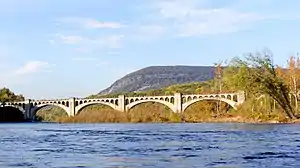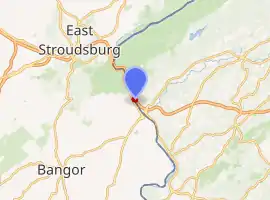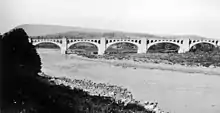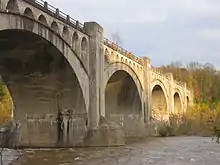Delaware River Viaduct
The Delaware River Viaduct is a reinforced concrete railroad bridge across the Delaware River about 2 miles (3.2 km) south of the Delaware Water Gap that was built in 1908-10 as part of the Lackawanna Cut-Off rail line. It is the sister to the line's larger Paulinskill Viaduct. The Delaware River Viaduct also crosses Interstate 80 on the east (New Jersey) side of the river and Slateford Road and the Lackawanna Railroad's "Old Road" (now Delaware-Lackawanna) on the west (Pennsylvania) side. Abandoned in 1983, it is part of an Amtrak proposal to introduce passenger service between Scranton, Pennsylvania and New York City, a distance of 135 miles (217 km) miles.
Delaware River Viaduct | |
|---|---|
 | |
| Coordinates | 40°56′15″N 75°06′21″W |
| Carries | Lackawanna Cut-Off |
| Crosses | Delaware River, I-80 |
| Locale | Between Portland, PA and Columbia, NJ |
| Characteristics | |
| Material | Reinforced concrete |
| Total length | 1,452 feet (443 m) |
| Width | 34 feet (10 m) |
| Height | 65 feet (20 m) |
| Longest span | 150 feet (46 m) |
| No. of spans | 9 |
| Piers in water | 6 |
| History | |
| Designer | Abraham Burton Cohen |
| Construction start | August 1908 |
| Construction end | December 1, 1910 |
| Opened | December 24, 1911 |
| Location | |

| |
The bridge is 1,452 feet (443 m) long and 65 feet (20 m) high from water level to the top of the rail, and is composed of five 150-foot (46 m) spans and two 120-foot (37 m) spans. It was considered the largest reinforced concrete structure in the world when it was completed in 1910.[1]
Design and construction
The bridge was originally envisioned as a curved bridge with a 1°30" curve that would have allowed speeds of 80 mph (129 km/hr).[2] But the design was altered to include a tangent (straight) stretch of track across the bridge, a 1°30" curve on the New Jersey side and a 3°30" curve on the Pennsylvania side of the bridge. This tighter curve required trains to slow to 50 mph (80 km/hr). No other curves on the 28-mile Cut-Off were sharper than 2°. (Later, the super-elevation of this curve was increased, bumping up the speed limit to 55 miles per hour (89 km/h).)
Construction of the bridge was described in a 1909 article by Abraham Burton Cohen, then a draftsman for the Delaware, Lackawanna and Western Railroad, who went on to design the Tunkhannock Viaduct, an even larger structure on the railroad's Clarks Summit-Hallstead Cut-Off.[3]

The footings were excavated down to bedrock, which ranges from 26 feet (7.9 m) to 53 feet (16 m) below the surface.[4] A total of 51,376 cubic feet (1,454.8 m3) of concrete and 627 tons of reinforcing steel were used to construct this bridge.
At its completion, the viaduct was thought to be the largest reinforced concrete structure built with a continuous pour process.[5]
There is no known evidence to support the legend that several workers fell into the concrete during construction and could not be extracted because of the need to keep pouring.
The bridge was completed on December 1, 1910, about a year before the Cut-Off opened, which allowed construction trains to haul building materials to work sites east of the bridge.[6]
Disuse and proposals for possible future use

The tracks on the viaduct were removed by Conrail in March 1989, five years after removal took place on the New Jersey section of the Cut-Off. Graffiti, cracking cement, other forms of concrete degradation and the growth of weeds all pose threats to structure following more than 30 years of disuse.
As of 2019, the Pennsylvania Northeast Railroad Authority (PNRRA) is gathering funding to commission a study to update the 2009 estimates of the costs of restoring service, including the bridge repairs.
In September 2020 Amtrak proposed the restoration of rail service between Scranton and New York City at somepoint before 2035.[7] The restoration of service along the Lackawana Railroad's previous route would require substantial repairs to the bridge as well as the reconstruction of the Lackawanna Cut-Off. In 2011 New Jersey Transit began reconstructing a 7.3-mile stretch of the 28-mile Lackawanna Cutoff in order to restore rail service to Andover, New Jersey but in November, 2020, the agency's spokeswoman said that without federal funding the Andover service wouldn’t begin until 2026.[8]
See also
References
- National Geographic Magazine, April, 1923, v.43, p.356, https://babel.hathitrust.org/cgi/pt?id=uc1.b3074428&view=1up&seq=376
- 1906 Survey Map of the Delaware Valley Cut-Off, September 1, 1906
- Cohen, A. B. "The Delaware River Viaduct." Purdue Engineering Review, No. 6 (1909-10): 9-18.
- Cohen, A. B. "The Delaware River Viaduct." Purdue Engineering Review, No. 6 (1909-10): 13.
- National Geographic Magazine, April, 1923, v.43, p.356, https://babel.hathitrust.org/cgi/pt?id=uc1.b3074428&view=1up&seq=376
- The Lackawanna Railroad in Northwest New Jersey, Larry Lowenthal and William T. Greenberg, Jr., Tri-State Railway Historical Society Inc. Publication, 1987, p. 74
- Amtrak proposes adding passenger train route from New York City to Scranton, By Borys Krawczeniuk, Scranton Times-Tribune, Nov 30, 2020, https://www.mcall.com/news/pennsylvania/mc-nws-pa-amtrak-expansion-scranton-20201130-5agzmgj7k5dgrintppe6d22wm4-story.html
- Amtrak proposes adding passenger train route from New York City to Scranton By Borys Krawczeniuk, Scranton Times-Tribune, Nov 30, 2020, https://www.mcall.com/news/pennsylvania/mc-nws-pa-amtrak-expansion-scranton-20201130-5agzmgj7k5dgrintppe6d22wm4-story.html
External links
| Wikimedia Commons has media related to Delaware River Viaduct. |
- Historic American Engineering Record (HAER) No. PA-541, "Delaware River Viaduct"
- Touring the Lackawanna Cut-Off